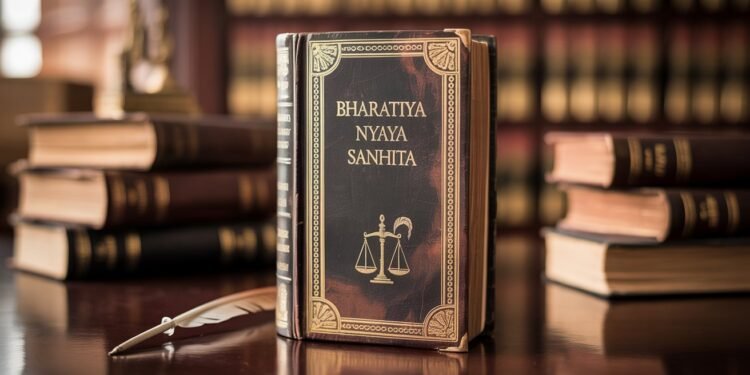Author: Ahana Karmakar a student of BBA LLB (H)
Sections: 351, 352, 353, 354,355 and 356.
Introduction
Bharatiya Naya Sanhita 2023, passed as Act No. 45 of 2023, has significantly reformed India’s criminal justice system and replaced the colonial Indian penal code 1860 IPC. Chapter 19 of BNS on Criminal Intimidation, Insult and Annoyance includes sections 351 to 356. This chapter protects personal dignity and public peace by imposing penalties on acts that threaten or annoy or so provoke individuals, including standard offences such as criminal intimidation, section 351. Intentional insult with intent to provoke breach of peace and criminal annoyance and provisions related to defamation, section 354 to 356. These laws are important for dealing with conflicts between individuals that have prospects of causing a public disturbance if not managed. The provisions are thus a modernized version with modern language penalties in comparison to IPC but retain the core concepts to protect people’s security. For instance, section 351 defines criminal intimidation as an act intended to alarm a person or coerce or cause the person to do an act against the will of the person with the punishment of either imprisonment for no more than two years for lesser variance and imprisonment for no less than six years for an aggravated form. So does Section 352 which penalizes insults likely to provoke a breach of peace and covers circumstances common to both in person and online interactions. Thus, this article analyzes chapter 19 in depth through relevant case law and thus proposes areas for improvement and makes conclusions about its effectiveness. It will thus look at what both say about the provisions in the context of current issues that impact the justice system particularly the issue of cyber harassment to point out both the strengths and weaknesses of the law relative to justice and public safety.
Definition
- (1) Whoever threatens another by any means, with any injury to his person, reputation or property, or to the person or reputation of any one in whom that person is interested, with intent to cause alarm to that person, or to cause that person to do any act which he is not legally bound to do, or to omit to do any act which that person is legally entitled to do, as the means of avoiding the execution of such threat, commits criminal intimidation.
(2) Whoever commits the offence of criminal intimidation shall be punished with imprisonment of either description for a term which may extend to two years, or with fine, or with both.
(3) Whoever commits the offence of criminal intimidation by threatening to cause death or grievous hurt, or to cause the destruction of any property by fire, or to cause an offence punishable with death or imprisonment for life, or with imprisonment for a term which may extend to seven years, or to impute unchastity to a woman, shall be punished with imprisonment of either description for a term which may extend to seven years, or with fine, or with both.
(4) Whoever commits the offence of criminal intimidation by an anonymous communication, or having taken precaution to conceal the name or abode of the person from whom the threat comes, shall be punished with imprisonment of either description for a term which may extend to two years, in addition to the punishment provided for the offence under sub-section (1).
- Whoever intentionally insults in any manner, and thereby gives provocation to any person, intending or knowing it to be likely that such provocation will cause him to break the public peace, or to commit any other offence, shall be punished with imprisonment of either description for a term which may extend to two years, or with fine, or with both.
- “(1) Whoever makes, publishes or circulates any statement, false information,
rumour, or report, including through electronic means—
(a) with intent to cause, or which is likely to cause, any officer, soldier, sailor or irman in the Army, Navy or Air Force of India to mutiny or otherwise disregard or fail in his duty as such; or
(b) with intent to cause, or which is likely to cause, fear or alarm to the public, or to any section of the public whereby any person may be induced to commit an offence against the State or against the public tranquillity; or
(c) with intent to incite, or which is likely to incite, any class or community of persons to commit any offence against any other class or community, shall be punished with imprisonment which may extend to three years, or with fine, or with both.
(2) Whoever makes, publishes or circulates any statement or report containing false information, rumour or alarming news, including through electronic means, with intent to create or promote, or which is likely to create or promote, on grounds of religion, race, place of birth, residence, language, caste or community or any other ground whatsoever, feelings of enmity, hatred or ill will between different religious, racial, language or regional groups or castes or communities, shall be punished with imprisonment which may extend to three years, or with fine, or with both.
(3)Whoever commits an offence specified in sub-section (2) in any place of worship or in any assembly engaged in the performance of religious worship or religious ceremonies, shall be punished with imprisonment which may extend to five years and shall also be liable to fine. Intentional insult with intent to provoke breach of peace. Statements conducing to public mischief.”
- “Whoever voluntarily causes or attempts to cause any person to do anything which that person is not legally bound to do, or to omit to do anything which he is legally entitled to do, by inducing or attempting to induce that person to believe that he or any person in whom he is interested will become or will be rendered by some act of the offender an object of Divine displeasure if he does not do the thing which it is the object of the offender to cause him to do, or if he does the thing which it is the object of the offender to cause him to omit, shall be punished with imprisonment of either description for a term which may extend to one year, or with fine, or with both.”
- “Whoever, in a state of intoxication, appears in any public place, or in any place which it is a trespass in him to enter, and there conducts himself in such a manner as to cause annoyance to any person, shall be punished with simple imprisonment for a term which may extend to twenty-four hours, or with fine which may extend to one thousand rupees, or with both or with community service.”
- (1) “Whoever, by words either spoken or intended to be read, or by signs or by visible representations, makes or publishes in any manner, any imputation concerning any person intending to harm, or knowing or having reason to believe that such imputation will harm, the reputation of such person, is said, except in the cases hereinafter excepted, to defame that person.”
Explanation and interpretation:
Section 351: if any individual threatens another by any means, with any injury to his person, reputation or property, or to the person or reputation of any one in whom that person is interested, with intent to cause alarm to that person, or to cause that person to do any act which he is not legally bound to do, or to omit to do any act which that person is legally entitled to do, as the means of avoiding the execution of such threat, commits criminal intimidation.
Section 352: if any individual intentionally insults in any manner, and thereby gives provocation to any person, intending or knowing it to be likely that such provocation will cause him to break the public peace, or to commit any other offence, shall be punished with imprisonment of either description for a term which may extend to two years, or with fine, or with both.
Section 353: This section criminalizes the act of making, publishing, or circulating false statements, rumors, or reports, including through electronic means (e.g., social media, messaging apps), that have specific harmful intentions or effects. It replaces Section 505 of the Indian Penal Code (IPC) and is designed to maintain public order, national security, and communal harmony in the context of modern communication technologies.
Section 354: Whoever threatens another with any injury to his person, reputation, or property, or to the person or reputation of any one in whom that person is interested, with intent to cause alarm to that person, or to cause that person to do any act which he is not legally bound to do, or to omit to do any act which that person is legally entitled to do, as the means of avoiding the execution of such threat, shall be punished with imprisonment of either description for a term which may extend to two years, or with fine, or with both.
- If the threat be to cause death of dubious sort, or to cause due to the destruction of any property by fire, or causing an offence punishable with death, or imprisonment for life, or with imprisonment for a term which may extend to seven years, or to impute unchastity to a woman, it shall be punished with imprisonment of either description for a term which may extend to seven years, or with fine, or with both.
- If any individual commits the offence of criminal intimidation by an anonymous communication or has intentionally taken precautions to conceal the name or abode of the person from whom the threat arises shall be punished with imprisonment of either destruction for a term which may extend to two years and in addition to the punishment provided by the offence of sub Section-1.
Section 355: Whoever assaults or uses criminal force with the intention of dishonoring the specific person and the action was not sudden in nature would thus commit an offence. However this is a cognizable offence.
Section 356: If any individual assaults or uses any sort of criminal force on any individual with the intention of committing theft of any object carried by that person it means that an offence has been committed. This offence is bailable and is cognizable in nature.
Case laws
Vikram Johar v. State of Uttar Pradesh (2019)
In this case Vikram Johar v. State of Uttar Pradesh (2019 SCC OnLine SC 609), the supreme court has explained the basic elements of criminal intimidation strictly under section 506, which is presently reflected Section 351 of BNS. In this case, there were general allegations of verbal threats made during a dispute. Thus, the court held that for there to be an act of criminal intimidation, there must be clear and credible threat intended to cause harm or to compel a course of action. It said that the use of abusive language or heated exchanges taken in isolation of anything showing an intent to harm is not sufficient. Further, the court held that it was up to the prosecution to prove the intent of the accused objectively and that must be evidenced by a. the context of alleged threat and b. the reasonable apprehension of the victim. Its ruling ensured that Section 351 could not be misapplied indiscriminately in minor disputes.
Manik Taneja v. State of Karnataka (2015)
Case: Manik Taneja v. State of Karnataka (AIR 2015 SC 803) provides an example of the increasing concern of alleged criminal intimidation in the digital space. The petitioners were accused of posting certain posts on social media which alleged offensive and malicious material related to a police officer. However, the Supreme Court held that if the statements were too vague or generalized, as long as they are not threatening, the statements have not reached the level of criminal intimidation. The Supreme Court has also noted that even if the statements were found to be offensive, unless the specifically threatened harm or reasonably installed fear or any sort of criminal intimidation, any sort of criminal intimidation had not occurred. This ruling is very significant about the threshold the police must meet under Section 351 and particularly in the context of digital or online interaction where it is extremely important to distinguish between offensive speech from actionable threats.
Recommendations
- Clarity definition refining:
Terms intimidation, insult, and annoyance in Section 351 to 356 are broadly worded, leading to subjective interpretations. For example, Section 351 defines criminal intimidation as an act causing harm or compelling action, but however, lacks specific examples of qualifying threats, e.g., threats to physical safety, property, or reputation. Including illustrative examples in the statute or explanatory notes would guide law enforcement and courts, thus reducing ambiguity and the broader ground. Similarly, Section 353’s reference to annoyance is vague, thus defining it in terms of measurable harm and would prevent overuse in trivial cases. - Frivolous Complaints safeguard:
Provisions like Section 352 penalizes intentional insults and are susceptible to misuse in personal or professional disputes. To address this, the BNS could mandate preliminary inquiries by the magistrate before registering a trial for such offences under these sections. Alternatively, introducing mandatory mediation for cases involving minor insults or annoyance could resolve disputes without clogging the judicial system. The approach aligns with the Supreme Court’s observation in Fiona Shrikhande v. State of Maharashtra, 2013, where vague allegations were dismissed to prevent harassment through legal processes. - Cyber offences addressal:
Media and digital communication has amplified instances of online intimidation and insult. While the Information Technology Act 2000 addresses some cybercrimes, intimidating specific provisions for cyber intimidation in Bijapur 90, whose streamlined prosecution, for instance, Section 351, could explicitly cover threats delivered via electronic means with guidelines on assessing digital evidence, the Manik Taneja case 2015 underscores the need for clarity in distinguishing online threats from mere offensive speech and the BNS could incorporate such judicial insights. - Peanlties of repeat offenders:
To deter habitual offenders, particularly in cases of stopping or repeated intimidation, Chapter 19 could introduce escalating penalties. For example, a second conviction under Section 351 could carry a higher minimum sentence or mandatory counselling. This would address recidivism, a concern in cases of domestic or workplace harassment where offenders often exploit lenient penalties. - Training of law enforcement and judicial magistrate:
law enforcement officers and judges should have specialized training to handle cases under Chapter 19, especially those involving digital platforms or marginalized communities. The judiciary could develop standardized guidelines, drawing from cases like Shreya Singhal 2015, to ensure the consistent application of these laws. The training should emphasize distinguishing between free speech and actionable offenses, particularly in potentially sensitive cases. - Public awareness along with victim support:
A certain number of victims of criminal intimidation or insults, especially women and marginalized groups, are aware of the legal remedies. The government could launch awareness campaigns through media and NGOs to educate the public about Chapter 19 provisions. Additionally, establishing dedicated helplines or legal aid clinics for victims of harassment could encourage reporting and ensure timely justice. - Time to time review of provisions:
Social interaction, particularly in the digital age, necessitates the periodic review of chapter 19. A statutory committee should be asked with evaluating the provision every five years, incorporating feedback from courts, law enforcement, and civil society. This would ensure that the law remains relevant and effective in addressing emerging challenges.
Conclusion
The provisions on criminal intimidation, insult, and annoyance are designed to protect individuals from threats and harassment, while maintaining a delicate balance with constitutional rights such as the free speech. The judicial precedents discussed, including Vikram Johar 2019 and Shreya Singhal 2015, highlight the judiciary’s role in refining the application of these laws, ensuring that they are neither misused nor overly restricted. However, challenges remain such as particularly adapting these provisions to the digital era, preventing their misuse in personal disputes. The recommendations that are provided are clear definitions and safeguards against frivolous complaints and enhanced focus on cyber-offences. Offer a roadmap for strengthening of Chapter XIX. By implementing these changes, lawmakers can ensure that the provisions are remaining relevant and effective in addressing contemporary forms of harassment such as cyber-bullying and workless intimidation. Moreover, the success of Chapter XIX depends on robust mechanisms, including trained law enforcement and an informed judiciary.BNS campaigns and victim support systems are equally critical to ensure that these laws reach those who need them the most. As India navigates the complexities of a rapidly evolving society, Chapter 19 must evolve to address new challenges while upholding the principles of justice and fairness. Thus, in conclusion of Chapter 19 of the BNS, it is a vital component of India’s criminal justice framework, with the potential to protect individuals and maintain public order, along with targeted reforms and proactive implementation. It can serve as a model for balancing individual rights with societal needs and ensuring a safer and more equitable society.
Refference
Bharatiya Nyaya Sanhita,2023
Case laws:
- Manik Taneja v. State of Karnataka (AIR 2015 SC 803)
- Vikram Johar v. State of Uttar Pradesh (2019 SCC OnLine SC 609)



